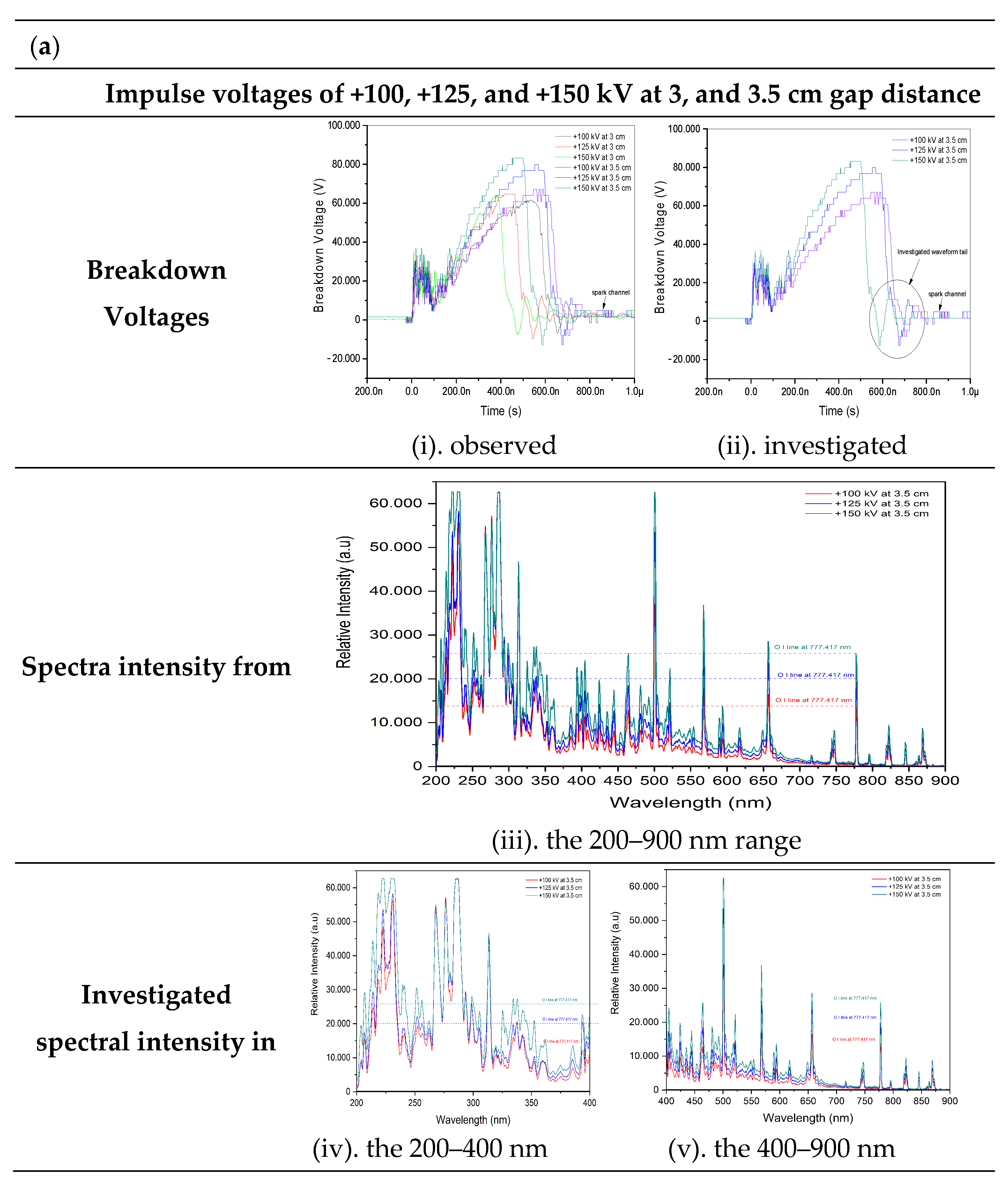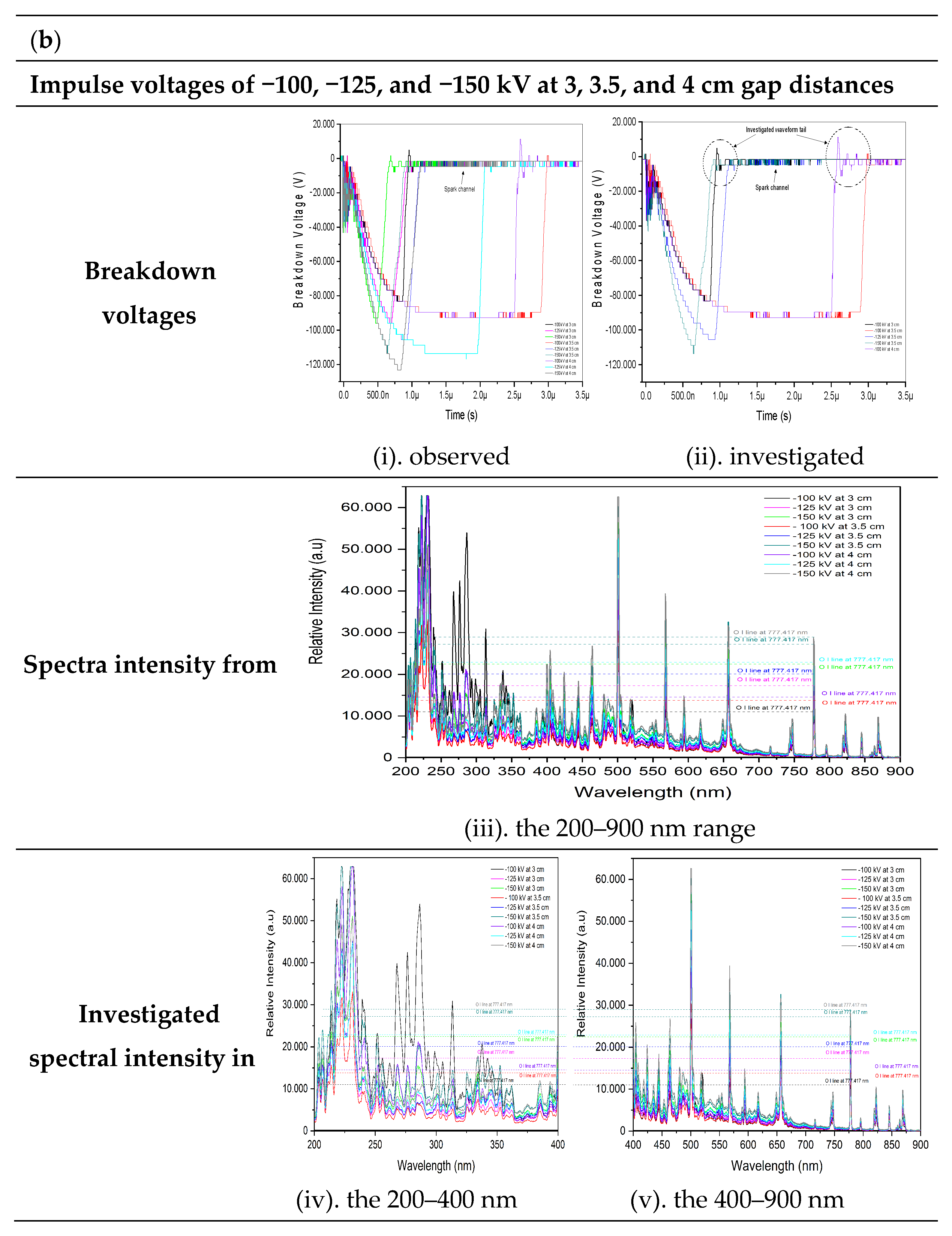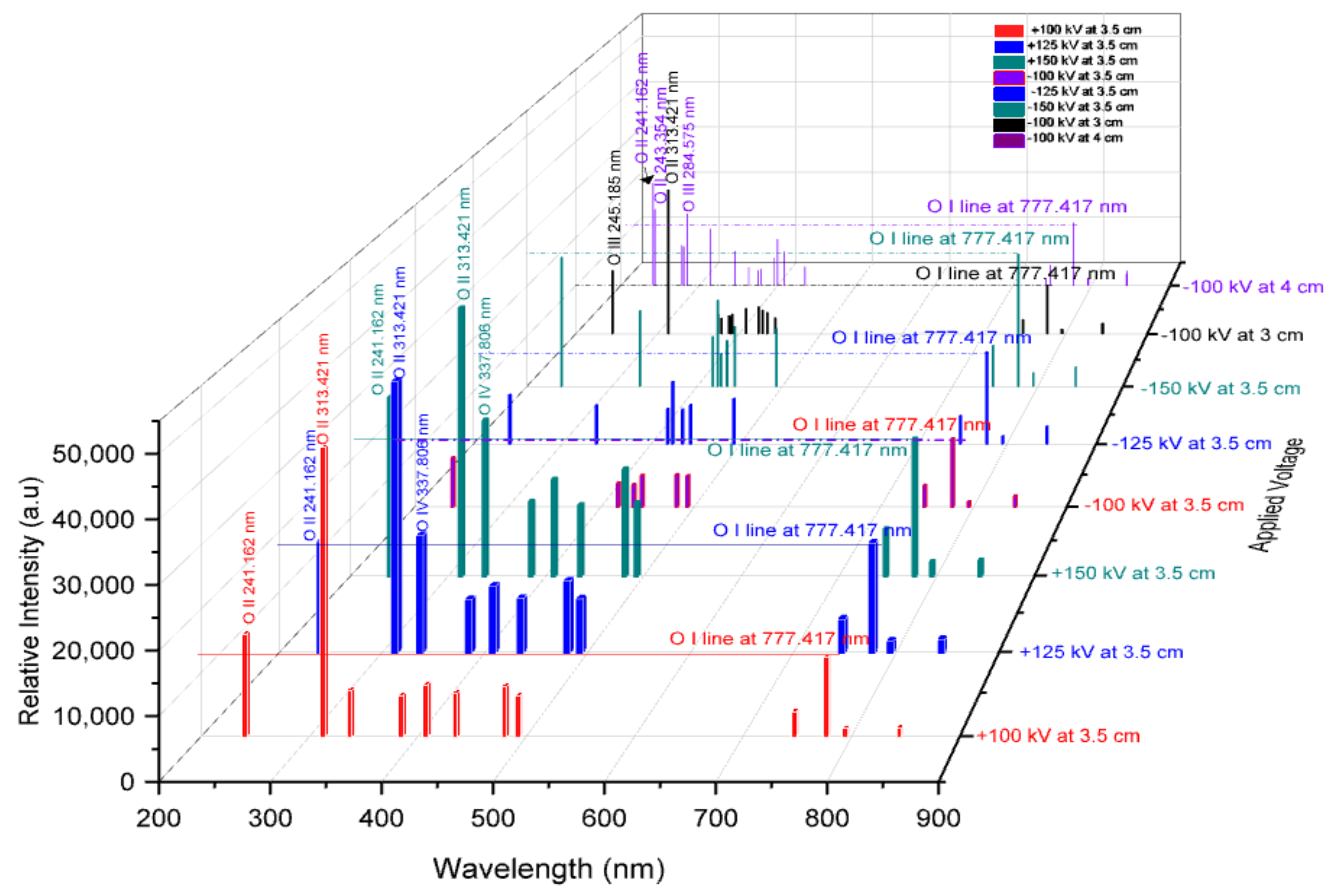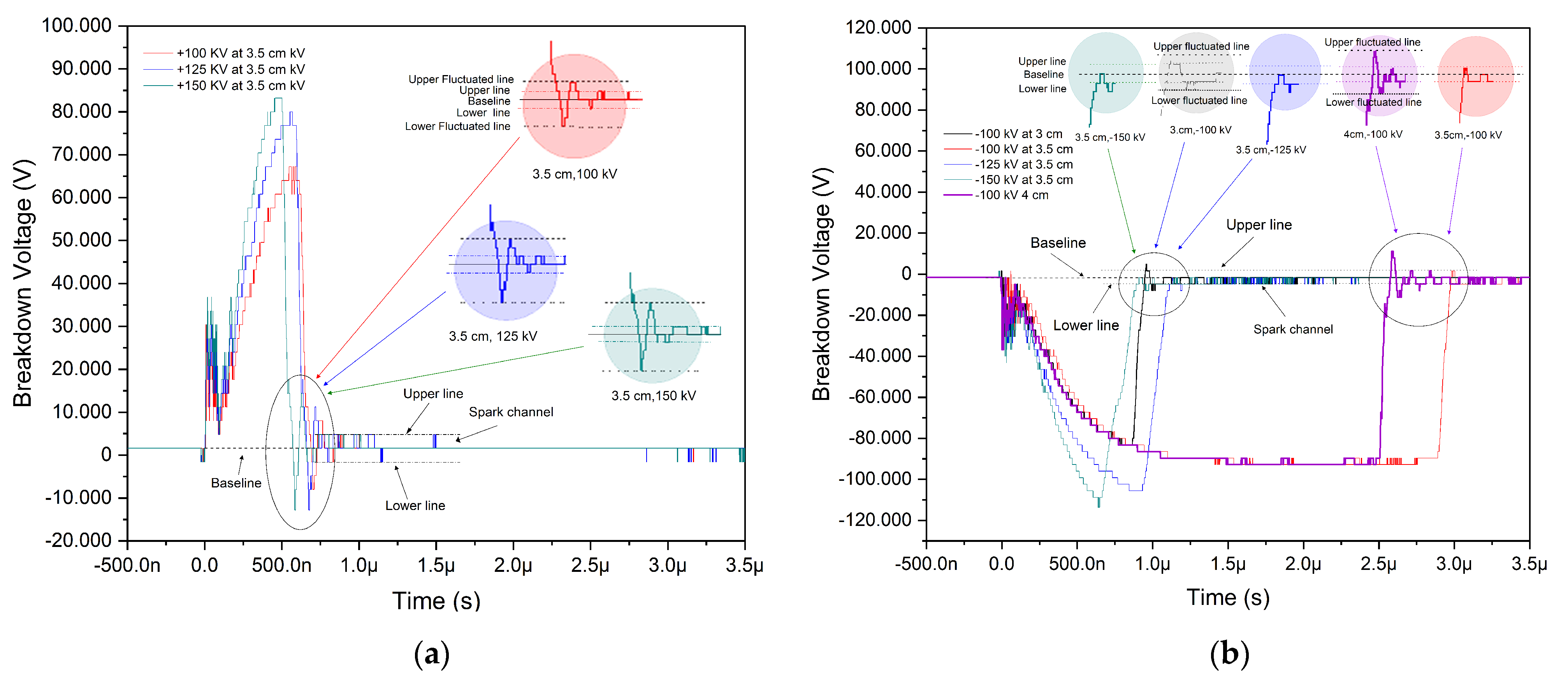Contribution of Metastable Oxygen Spectra to Fluctuated Waveform Tails after Breakdown Time in Air under Positive and Negative Impulse Voltages
Abstract
:1. Introduction
2. Materials and Methods
3. Results
3.1. Breakdown Voltages and Spectra
3.2. Spectral Line Identifications and Oxygen Distributions
4. Discussion
4.1. Waveform Tails and Oxygen Distributions
4.2. Fluctuated Waveform Tail Identifications
4.3. Correlation of Waveform Tails and Spectral Lines with Breakdown Time
5. Conclusions
- We observed no fluctuation in the waveform tails after breakdown time exceeding upper and lower lines in the case of −100, −125, and −150 kV at 3.5 cm, as well as −125, and −150 kV across 3 cm and 4 cm because no oxygen excited states were observed with higher intensities compared to the neutral oxygen O I line at 777.417 nm. In contrast, in +100, +125, and +150 kV at 3.5 cm, along with −100 kV at 3 cm and 4 cm, we examined symmetrical fluctuated waveform tails after breakdown exceeding upper and lower lines (spark channel) due to more intense oxygen excitation with higher peak intensities within the wavelength range of 200–400 nm during the spark phase compared to neutral oxygen at 777.417 nm, as discussed in Section 4.2. These emissions, spectral lines with higher peak intensity in the 200–400 nm ranges than OI at 777.417 nm, are highlighted as fluctuated waveform tails surpassing the spark channel level during the spark phase, as discussed in Section 4.1.
- Examining the fluctuations in the spark phase of the waveform tails for both positive and negative impulse voltage discharges, we identified small fluctuations that exceed the spark channel after breakdown time for both voltage types. These fluctuations contribute to rapid breakdown times in +100, +125, and +150 kV at 3.5 cm as well as −100 kV at 3 cm and 4 cm with 101, 96, 73, 83, and 95 ns, respectively, as discussed in Section 4.3. These fluctuations were attributed to energetic photon emissions, indicated by higher peak intensities in excited states compared to neutral states, which facilitate the acceleration of electrons towards the ground plane resulting in rapid breakdown time.
- A correlation has been identified between the symmetrical fluctuated waveform tails and the spectral lines of oxygen excitation in the 200–400 nm range for both positive and negative impulse voltages. The fluctuated waveform tails after breakdown time, which reflect a higher peak intensity of oxygen distributions in the 200–400 nm wavelength range than the O I line at 777.417 nm, significantly influence the dynamics of the electrical discharge contributing to a quicker breakdown process in both positive and negative impulse voltages.
Author Contributions
Funding
Data Availability Statement
Acknowledgments
Conflicts of Interest
References
- Sigmond, R.S.; Goldman, M. Streamer to Spark Transition in Short Point to Plane Gaps. In Gaseous Dielectrics III, Pergamon, Proceedings of the Third International Symposium on Gaseous Dielectrics, Knoxville, TN, USA, 7–11 March 1982; Elsevier: Amsterdam, The Netherlands, 2013; pp. 53–59. [Google Scholar]
- Machala, Z.; Janda, M.; Niklova, A.; Martisovits, V. Time-resolved emission spectroscopy and imaging of transient spark in atmospheric air. In Proceedings of the 6th International Workshop on Microplasmas, Paris, France, 3–6 April 2011. [Google Scholar]
- Hogg, M.G.; Timoshkin, I.V.; Mcgregor, S.J.; Wilson, M.P.; Given, M.J. Polarity effects on breakdown of short gaps in a point-plane topology in air. IEEE Trans. Dielectr. Electr. Insul. 2015, 22, 1815–1822. [Google Scholar] [CrossRef]
- Zhou, Z.; Kyritsakis, A.; Wang, Z.; Li, Y.; Geng, Y.; Djurabekova, F. Direct observation of vacuum arc evolution with nanosecond resolution. Sci. Rep. 2019, 9, 7814. [Google Scholar]
- Forestier, B.; Houard, A.; Revel, I.; Durand, M.; Andre, Y.B.; Prade, B.; Jarnac, A.; Carbonnel, J.; Nevé, M.; Miscault, J.; et al. Triggering, guiding and deviation of long air spark discharges with femtosecond laser filament. AIP Adv. 2012, 2, 012151. [Google Scholar] [CrossRef]
- Hu, Y.; Lin, Y.; An, Y.Z.; Wen, X.; Li, H.; Su, M.; Yang, M.; Yin, K. Laboratory study on negative spark inception direction and breakdown characteristics in rod–rod air gaps. Electr. Power Syst. Res. 2021, 201, 107498. [Google Scholar] [CrossRef]
- Gallimberti, I.; Bacchiega, G.; Bondoiu-Clergerie, A.; Lalande, P. Fundamental processes in long air gap discharges. Comptes Rendus Phys. 2002, 3, 1335–1359. [Google Scholar] [CrossRef]
- Raizer, Y.P. Breakdown of Gases in Fields of Various Frequency Ranges. In Gas Discharge Physics; Springer: Berlin/Heidelberg, Germany, 1991; pp. 128–144, Chapter 7. [Google Scholar]
- Sun, P.; Sima, W.; Yang, M.; Lan, X.; Wu, J. Study on voltage-number characteristics of transformer insulation under transformer invading non-standard lightning impulses. IEEE Trans. Dielectr. Electr. Insul. 2015, 22, 3582–3591. [Google Scholar] [CrossRef]
- Sima, W.; Sun, P.; Yang, M.; Wu, J.; Hua, J. Impact of time parameters of lightning impulse on the breakdown characteristics of oil-paper insulation. High Volt. 2016, 1, 18–24. [Google Scholar] [CrossRef]
- Wu, S.; Wang, L.; Gao, J.; Xie, C.; Liu, L.; Wang, T.; Li, E. Breakdown characteristics of combined air gaps under lightning impulse. AIP Adv. 2022, 12, 035024. [Google Scholar] [CrossRef]
- Korolov, I.; Donkó, Z.; Hübner, G.; Bischoff, L.; Hartmann, P.; Gans, T.; Liu, Y.; Mussenbrock, T.; Schulze, J. Control of electron dynamics, radical and metastable species generation in atmospheric pressure RF plasma jets by Voltage Waveform Tailoring. Plasma Sources Sci. Technol. 2019, 28, 094001. [Google Scholar] [CrossRef]
- Gudmundsson, J.T.; Snorrason, D.I. On electron heating in a low pressure capacitively coupled oxygen discharge. J. Appl. Phys. 2017, 122, 193302. [Google Scholar] [CrossRef]
- Waters, R.T. Positive discharges in long air gaps at Les Renardières. Electra Cigre 1977, 53, 31–132. [Google Scholar]
- Ikhwanus, M.; Morimoto, T. Breakdown Time Phenomena: Analyzing the Conductive Channel of Positive Impulse Voltage Discharges under Standard Temperature and Pressure Air Conditions. Energies 2024, 17, 4222. [Google Scholar] [CrossRef]
- Ikhwanus, M.; Morimoto, T. Rapid Breakdown Time in Positive Impulse Voltages through Spectroscopy Analysis. Energies 2024, 17, 705. [Google Scholar] [CrossRef]
- NIST Atomic Spectra Database Lines Form. Available online: https://physics.nist.gov/PhysRefData/ASD/lines_form.html (accessed on 24 June 2024).
- Hansjoachim, B. Pulsed Power Systems Principles and Applications; Springer: Berlin/Heidelberg, Germany, 2006; pp. 17–18. [Google Scholar]
- Janet, L.; Pralhad, R. Foundations of Pulsed Power Technology; John Wiley & Sons, Inc.: Hoboken, NJ, USA, 2017; pp. 158–162. [Google Scholar]
- Van der Horst, R.M.; Verreycken, T.; van Veldhuizen, E.M.; Bruggeman, P.J. Time-resolved optical emission spectroscopy of nanosecond pulsed discharges in atmospheric-pressure N2 and N2/H2O mixtures. J. Phys. D App. Phys. 2012, 45, 345201. [Google Scholar] [CrossRef]






| Ions | Wavelength (nm) | Intensity (a.u) in the Applied Voltage of | |||||||
|---|---|---|---|---|---|---|---|---|---|
| +100 kV | +125 kV | +150 kV | −100 kV | −125 kV | −150 kV | −100 kV | −100 kV | ||
| Gap Distances at 3.5 cm, | 3 cm, and | 4 cm | |||||||
| O II | 241.162 | 16,237 | 18,630 | 31,245 | 9072 | 9490 | 25,825 | - | 22,235 |
| O II | 243.354 | - | - | - | - | - | - | - | 16,493 |
| O III | 245.185 | 13,291 | - | ||||||
| O V | 278.101 | - | - | - | - | - | - | - | 8661 |
| O I | 280.558 | - | - | - | - | - | - | - | 8411 |
| O III | 284.575 | - | - | - | - | - | - | - | 15,471 |
| O II | 313.421 | 45,457 | 45,041 | 46,765 | - | - | - | 30,015 | - |
| O II | 313.834 | - | - | - | - | - | - | - | 12,236 |
| O III | 333.241 | - | - | - | - | - | 15,193 | - | - |
| O IV | 337.806 | 7430 | 19,561 | 27,246 | - | - | - | - | - |
| O IV | 338.552 | - | - | - | - | 7471 | - | - | - |
| O II | 345.31 | - | - | - | - | - | - | - | 7452 |
| O IV | 363.134 | - | - | - | - | - | - | - | 3931 |
| O IV | 374.664 | - | - | - | - | - | - | 4080 | - |
| O II | 374.888 | - | - | - | - | - | - | - | 3236 |
| O IV | 378.738 | - | - | - | - | - | - | 3335 | 3521 |
| O II | 382.154 | - | - | - | - | - | - | - | - |
| O II | 385.238 | 6617 | 9030 | 13,130 | - | - | - | - | - |
| O III | 387.676 | - | - | - | - | - | - | 3888 | - |
| O III | 389.176 | - | - | - | - | - | - | 3715 | - |
| O II | 391.929 | - | - | - | - | - | - | 4159 | - |
| O II | 394.935 | - | - | - | - | - | - | - | 5970 |
| O I | 399.795 | - | - | - | - | - | - | - | 9908 |
| O III | 408.426 | 8340 | 11,200 | 16,956 | - | - | - | - | - |
| O II | 408.465 | - | - | - | - | - | - | 5365 | - |
| O II | 408.659 | - | - | - | - | - | - | - | 7332 |
| O II | 418.545 | - | - | - | 4410 | 6812 | 9991 | - | - |
| O III | 423.948 | - | - | - | - | - | - | 5757 | - |
| O II | 424.477 | - | - | - | - | 11,888 | 17,258 | - | - |
| O II | 428.412 | - | - | - | - | - | 6658 | - | - |
| O II | 428.882 | - | - | - | - | - | - | 4952 | - |
| O II | 434.742 | - | - | - | - | - | - | - | 3995 |
| O II | 434.943 | - | - | - | - | - | - | 4493 | - |
| OII | 435.359 | - | - | - | 4161 | 6637 | 9219 | - | - |
| O II | 435.418 | 7022 | 9196 | 12,524 | - | - | - | - | - |
| O II | 444.352 | - | - | - | 5851 | 7528 | 11,957 | 3357 | - |
| O III | 473.254 | - | - | - | - | - | - | - | - |
| O III | 480.978 | 8088 | 12,050 | 18,772 | - | - | - | - | - |
| O IV | 481.315 | - | - | - | 5978 | - | - | - | - |
| O III | 493.123 | 6548 | 9120 | 12,867 | 5797 | 8727 | 11,511 | - | - |
| O V | 742.236 | - | - | - | - | - | - | - | 1470 |
| O I | 747.724 | - | - | - | 3979 | 5465 | 8258 | - | - |
| O II | 747.890 | - | - | - | - | - | - | 3138 | - |
| O I | 747.908 | 4081 | 5778 | 8312 | - | - | - | - | 4455 |
| O I | 777.417 | 12,631 | 18,356 | 23,929 | 12,477 | 17,563 | 26,413 | 10,287 | 13,510 |
| O I | 795.080 | 1440 | 2112 | 2622 | 1028 | 1569 | 2834 | 1120 | 1649 |
| O III | 796.332 | - | - | - | - | - | - | 1005 | 1492 |
| O I | 844.676 | 1511 | 2406 | 2868 | 2022 | 3368 | 3986 | 2107 | 2477 |
| O III | 845.642 | - | - | - | - | - | - | 2256 | 3139 |
| Applied Voltage | Gap Distance (cm) | ||
|---|---|---|---|
| 3.0 | 3.5 | 4.0 | |
| 100 kV | (6.349 − 5.299) × 10−7 = 1.05 ×10−7 = 105 ns | (6.887 − 5.877) × 10−7 = 1.01 × 10−7 = 101 ns | - |
| 125 kV | (5.179 − 4.489) × 10−7 = 0.69 ×10−7 = 69 ns | (6.662 − 5.703) × 10−7 = 0.96× 10−7 = 96 ns | - |
| 150 kV | (4.539 − 3.769) × 10−7 = 0.77 ×10−7 = 77 ns | (5.699 − 4.969) × 10−7 = 0.73 × 10−7 = 73 ns | - |
| −100 kV | (9.488 − 8.658) × 10−7 = 0.83 × 10−7 = 83 ns | (29.930 − 27.715) × 10−7 = 2.215 × 10−7 = 221 ns | (25.70 − 24.75) × 10−7 = 0.95 × 10−7 = 95 ns |
| −125 kV | (8.87 − 6.46) × 10−7 = 2.41 × 10−7 = 241 ns | (11.555 − 9.435) × 10−7 = 2.12 × 10−7 = 212 ns | (20.63 − 17.88) × 10−7 = 2.75 × 10−7 = 275 ns |
| −150 kV | (6.67 − 4.95) × 10−7 = 1.72 × 10−7 = 172 ns | (9.142 − 6.432) × 10−7 = 2.71 × 10−7 = 271 ns | (12.78 − 8.5) × 10−7 = 4.28 ×10−7 = 428 ns |
Disclaimer/Publisher’s Note: The statements, opinions and data contained in all publications are solely those of the individual author(s) and contributor(s) and not of MDPI and/or the editor(s). MDPI and/or the editor(s) disclaim responsibility for any injury to people or property resulting from any ideas, methods, instructions or products referred to in the content. |
© 2024 by the authors. Licensee MDPI, Basel, Switzerland. This article is an open access article distributed under the terms and conditions of the Creative Commons Attribution (CC BY) license (https://creativecommons.org/licenses/by/4.0/).
Share and Cite
Ikhwanus, M.; Morimoto, T. Contribution of Metastable Oxygen Spectra to Fluctuated Waveform Tails after Breakdown Time in Air under Positive and Negative Impulse Voltages. Eng 2024, 5, 2264-2279. https://doi.org/10.3390/eng5030117
Ikhwanus M, Morimoto T. Contribution of Metastable Oxygen Spectra to Fluctuated Waveform Tails after Breakdown Time in Air under Positive and Negative Impulse Voltages. Eng. 2024; 5(3):2264-2279. https://doi.org/10.3390/eng5030117
Chicago/Turabian StyleIkhwanus, Muhammad, and Takeshi Morimoto. 2024. "Contribution of Metastable Oxygen Spectra to Fluctuated Waveform Tails after Breakdown Time in Air under Positive and Negative Impulse Voltages" Eng 5, no. 3: 2264-2279. https://doi.org/10.3390/eng5030117
APA StyleIkhwanus, M., & Morimoto, T. (2024). Contribution of Metastable Oxygen Spectra to Fluctuated Waveform Tails after Breakdown Time in Air under Positive and Negative Impulse Voltages. Eng, 5(3), 2264-2279. https://doi.org/10.3390/eng5030117






